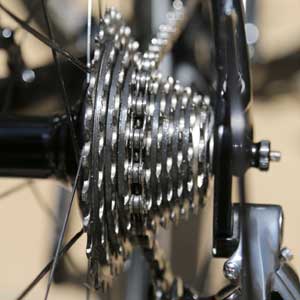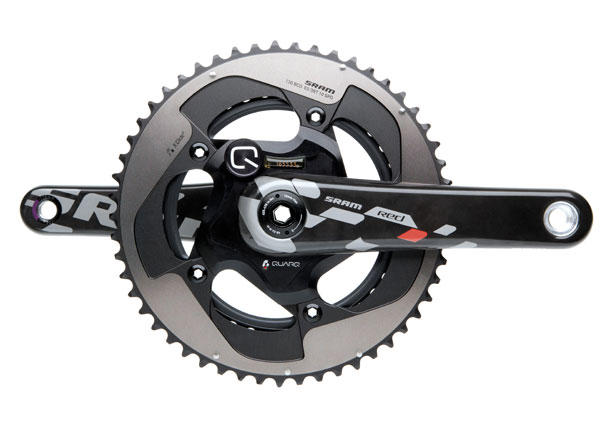SRAM Goes Big for 2013

All three major component manufacturers are officially on board with 11 speed. SRAM teased with a Youtube video, but kept cycling consumers off-balance by choosing April 1 as the video release date!
The question over the Winter was whether SRAM would respond to the relentlessly aggressive pace in component — especially drivetrain — technology with electronic, hydraulic or 11 speeds. The answer is no, yes and yes.
By offering an 11-speed cassette SRAM is not moving the ball forward, just coming up to par. Both Shimano and Campagnolo are and have been shipping 11-speed drivetrains. In fairness, SRAM has had 11-speed for awhile, just not in road. Last year it introduced the single-chain-ring XX1 group for off-road, primarily for Enduro racing and maybe some downhill, and really any riders who don’t need an extremely wide-ratio gear range. As an aside, I would be shocked if XX1 technology does not at least warrant a sniff from time trial and triathlon enthusiasts who find the idea of a 50-tooth ring and an 11-speed 10 x 42 tooth cassette at least worth contemplating.
SRAM also introduced hydraulic brakes into its road drivetrains, leveraging technologies from its Avid division. Two options are available, a hydraulic rim brake and road hydraulic disk brake, and there are backward compatible options for those (like me) who’re still mostly anchored to 10-speed.
True 22
SRAM calls its new 11-speed system “True 22” because, contrary to traditional wisdom, you need not fret about the two verboten gear combinations: “big-big” and “small-small”. It is acceptable with this drivetrain to ride in the big chainring and the largest cog and with the converse arrangement. That point was demonstrated through test rides of these drivetrains aboard Specialized Roubaix bikes outfitted with SRAM Red and Force 22-speed systems.
SRAM’s claim is valid. There are 22 usable gears afforded the rider on these drivetrains. But two things bear mentioning. Shimano’s 22-speed drivetrains also function in this way, and today’s higher-end bicycle drivetrains are so marvelously built that this functionality is now a requirement. Second, while the drivetrain can deliver 22 usable gears, most road race bikes are built with chain stay lengths in the neighborhood of 41cm to 42cm long. Most tri bikes are built with chain stays in the 38.5cm to 39.5cm range. Couple these short chain stays with a 16-tooth differential in the chain rings (50×34, 52×36) and I’d be shocked if the chain doesn’t go ping, ping, ping on the inside of the big chain ring while in small-small and maybe even in the cog next-to-small. This is not SRAM’s fault, it’s just geometry. It's True 22 almost all the time, but, my guess is that it's 21 on your tri bike.
Yaw FD
SRAM escaped the beating it deserved for not allowing sufficient front derailleur trim options. Bicycle tech editors pretty much gave SRAM a pass for what their own readers on their own message boards realized and wrote about: SRAM’s front derailleurs did not have the requisite trim options. Last year SRAM introduced its yaw front derailleur technology, where its front derailleur doesn’t simply move inward and outward, but sweeps in an arc, eliminating the need to trim the front derailleur at all. While not exactly straightforward and intuitive to set up, once this FD is adjusted properly wow did it work nicely.

The biggest single thing SRAM showed, in terms of pure function and use for more otherwise disadvantaged riders, over this past week, was the downstreaming of its yaw front derailleur technology to Force. This is huge for SRAM and I’ll touch on this further below.
Hydraulic disk brake
Good ideas in mountain biking elbow their way into road cycling and we’ve seen that with fork design (1 1/8” steer columns, and oversized crown race bearings), 31.8mm handlebar clamps and, really, much of the front end of a road bike, top to bottom. I rode a Roubaix outfitted with a SRAM Red hydraulic disk brake and it worked perfectly. SRAM also introduced a standard-mount hydraulic brake.
The master cylinder is housed in the shift lever and, while odd looking by virtue of an extra centimeter of height in the lever’s “bump”, the lever itself loses none of its good ergonomics. You can see this in the image just below. As noted, these hydraulic brake options are retrofittable to 10sp SRAM groupkits.

The hydraulic version of a standard caliper type brake (a hydraulic brake that looks a lot like your existing cabled brake caliper) is called HRR (Hydraulic Road Rim), and is pictured just above. The mountain bike style disk hydraulic brake system for road is called HRD (Hydraulic Road Disk). These are 11-speed systems. The 10-speed versions of these hydraulic brake systems is called S700. So, you have Red and Force 22-speed iterations of these hydraulic brake options, and you also have the S700 editions of these hydraulic brakes, which will go on 10sp systems.
If you retrofit your existing 10sp system, you can’t just buy brakes, because the brake master cylinder is housed in the shift lever. You have to buy the shifter and the brake to move from 10sp mechanical (cabled) to 10sp hydraulic. Further, of course, you can’t move to the HRD system (disk brake system) unless you also have a wheel hub onto which you can mount a disk, and a fork on your bike that accepts the disk caliper. Therefore, I don’t see much future for the HRD S700 (10sp hydraulic disk brake) system.
I suppose it helps if you already ride a mountain bike and are used to the feel and modularity of a hydraulic disk, but I was immediately at home with this road disk brake system. Now, you might wonder why a road bike would need a disk brake at all. Don’t road brakes work fine? Yes, they do… ideally.
If you think about it, there are some times when standard brakes don’t work as well as they might, and it’s chiefly in the rain, and when the wheel such brake is supposed to stop is not functioning in an optimized fashion: when you break a spoke; when the wheel comes out of true; when the wheel comes out of round; when you dent your rim. This is when standard rim brakes don’t work as they ought. Then there’s the issue of wheel changes, and varying rim widths when moving from a training to a race wheel. That’s becoming more and more problematic with tri bikes that have hidden brakes, and 25mm and even 27mm race wheel rim widths that slide into brake pads spaced for your 20mm training wheel rim width. Aargh!
Because a disk brake caliper mounts to the hub, all the problems associated with wheels that offer imperfect rim braking surfaces are moot.

Does this mean we’ll see disk brakes in triathlon? There are some theoretical advantages, and some of these are obvious in my list of benefits above. Further, frame manufacturers wouldn’t need to worry about where to put the front and rear standard rim brake calipers. That’s huge. Remember, no one has yet made an aero wheelset that does not require a braking surface. Imagine what you could do to chain stays, fork blades, fork crowns, rim shapes, rim weight, if you didn’t have to worry about brake calipers!
But aren’t you just transferring your aerodynamic problems to a different place on the bike? Instead of having to solve the front brake problem, you now have to solve the problem of the aerodynamics of that big front rotor and caliper down at the hub. You might think a road bike rotor could be a lot smaller, but I can imagine braking frequently on a high-speed, 15-minute descent. I can’t imagine applying that amount of resistance to my mountain bike braking system. The heat absorbed by that rotor during a road bike descent could well outstrip the needs of any mountain bike, so, SRAM’s rotor on its road system is 160mm front and rear, and I don’t know that there’s any getting away from that unit some better scheme of cooling rotors is developed. I’m surprised the rotor diameter didn’t turn out to be even larger, but, SRAM did extensive testing on gnarly descents with riders weighted like horse jockeys to simulate 250-pound bike/rider combos, and 160mm seems a sufficient diameter. We may not be seeing road hydraulic disk on tri bikes immediately, although we’re obviously already seeing hydraulic in tri via the Cervelo P5’s sexy Magura set up.

There is, at present, no hydraulic front brake lever from SRAM that plugs into a pursuit bar, so, this is as of now really a road and cross platform. But I would not be surprised to find out that SRAM is working on the down-low with at least one triathlon OEM right now on at least a rim-based hydraulic solution. Yes, disk brakes are legal in no-draft triathlon, just, to the best of my knowledge, not (yet) in draft-legal tri.
Are there any weight weenies who read Slowtwitch? [/pink font] If you move to the disk hydraulic option, you’re going to gain all the advantage described above, plus the theoretical advantage of frame, fork and wheel design that do not require rim brake surfaces. But these advantages come with a weight penalty, system wide, of about a half-pound in total. That’s how much more the bike is going to weigh. Now, this is before any weight savings are realized through a redesign of framesets that do not contemplate standard brakes. Also, tri bike brakes weigh more as the bikes get pricier, that is, the more expensive a bike is, the more likely it has custom center pull and bottom-mount, etc., calipers that certainly weigh more than standard Shimano or SRAM brakes, so, the weight penalty to disk brakes is theoretically less than that half-pound per bike quoted.
Cranks
SRAM Red is now offered in lengths down to 165mm, which is probably because SRAM loves triathletes, but ought to always have been the case for road. We recounted the theories of how to calculate optimal crank length and I don’t have any special wisdom here, except to note that the difference in height between a 5’2” rider and a 6’2” rider is 25cm, and if you just take half that distance — figuring that morphological changes above the waist do not inform on crank length — the half-cm difference between a 170mm and 175mm crank seems not enough to cover that 12cm or 13cm difference in leg lengths that span riders a foot apart in height. Yet that’s what is generally available for OEMs to place on their bikes. So, 165mm is welcome. Further, this allows bike builders to design road bikes on smaller sizes with 5mm less front/center, which means (decoded, for those who are not bike propeller-heads) women can ride bikes that fit them better if these bikes are designed around shorter cranks. We’ve covered this topic in more detail.
Quarq
For short crank arm fans, it gets better yet with Quarq’s new offerings, in that you can get these babies now down to 162.5mm, which places Quarq’s cranks in a better place to battle Rotor, which has been the most notable option for those who want to ride short cranks with crank-based power meters. Rotor still has an edge in this category, with crank arms down to 155mm.
Quarq has incorporated SRAM’s Exogram technology as well, shaving 25 grams off their crank weight via the use of hollow arms.
Force
The big news — really, the biggest news of SRAM’s launch this week — is that its Force group incorporates both yaw front derailleur technology and 11-speed. And available hydraulic brakes, for that matter. Thankfully for those who want to ride bikes that don’t have price tags equaling those of entry level cars, yaw technology flows down to Force. Rival and Apex? I’m sure that everybody — including SRAM’s own folks — are anxious for this front derailleur function to flow throughout all its price points.

WiFLi also migrates to this groupkit, and I’ve been riding around on a SRAM Red 10-speed WiFLi set up for some months now, 50×34 by 11-32. The medium cage derailleur required to suck up the extra chain needed for that 32-tooth cog does not make the shifting suffer (my experience with other longer cage road systems have not always been as positive).
I don't want to dive too deep into this, but I would like to see WiFLi used more often in tri, because of the tactics used in a no-draft race. Your effort is not staccato, as in a bike race, rather is metered more evenly. So, if your target power is, say, 180 watts, and you weight 150 pounds, and you intend to ride 85rpm, and you’re climbing a sustained 7 percent grade, well, what gear is that? What gear do you need to accomplish this? You’d be surprised how often you’ll use a 32-tooth cog on your tri bike if you live in a hilly area.
In fact, I’m interested in seeing if this precise set-up is not what is used in this year's Amgen Tour of California’s TT: a WiFLi drivetrain on a TT bike. If not in the men's pro ranks, at least among at least one of the pro women who'll race the TT as an exhibition. Wait, watch, and see if somebody doesn’t do just that.
Zipp
One thing about SRAM — and I’ve written this before — it does a better job of integrating its acquisitions than any company I’ve every seen. In any industry. What SRAM introduced this week would not be possible without the combined brain trust of Truvativ, Quarq, Zipp, Sachs-Huret and Avid: all companies that SRAM bought and absorbed into the SRAM family and, really, Rockshox is the only company that didn’t throw something into this technical potpourri. What is Zipp’s part in SRAM’s launch? Its 303 wheel now comes in a disk brake option. I rode around on a Specialized Roubaix with this wheel and these disk brakes (its hub is pictured below) and, if you think about it, the bike makes sense.

Many if not most cyclocrossers now swear by disk brakes even though UCI legality of this technology is not much more than a year old. Nasty, inclement-weather road riding — what you might find if you live in, say, the Pacific Northwest — seems to me to be the next step in disk brake utility, and that’s just the weather we’re talking about, not the road surface. Zipp worked hard on a wheel that would not break or buckle in the worst road conditions and retasked the 303 for that specific purpose.
As a consequence anyone who rides his road bike around on 25mm all-season tires; who glories in his ability to conquer “rideable dirt” on his road machine; is a prime candidate for a road bike disk brake, and Zipp’s 303 wheel is certainly in the discussion as the best deep carbon wheel for the pavés.
To put a proper coda on this, I guess what I like most about SRAM's push for 2013 is that it's so interdisciplinary. Once while at Mammoth Mountain I saw a ski patrolman ripping telemark turns on a backcountry rig, and I saw him later in the lodge. "When do you determine whether to make a parallel or a tele turn?" I asked. "I don't know," he answered. "It's just skiing."
I think if a Colnago Super from 1976 mated with an 80s era Gary Fischer, and they had a baby — well, maybe a grandbaby — it would be the kind of bike I like to ride: mostly road, but with a hydraulic disk brake, 25mm tires, and spitload of available gears, one of which can climb a wall.
What I like most about all of SRAM's technology is that I don't have to choose between road or mountain technologies. "It's just riding."



